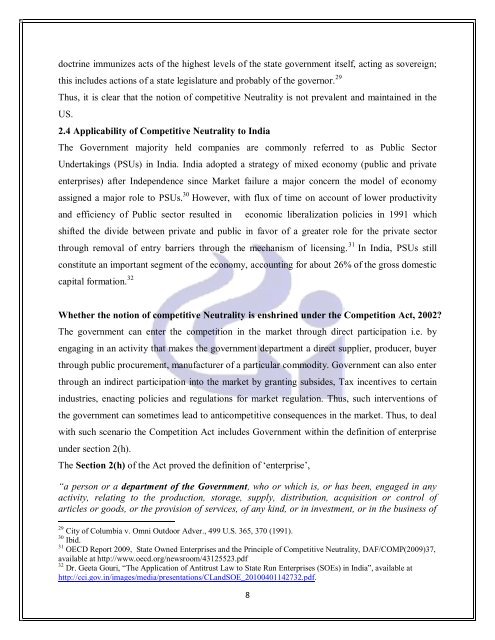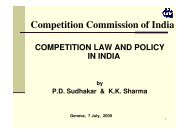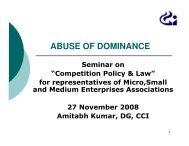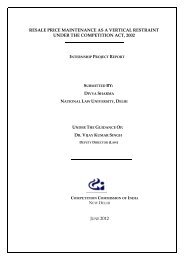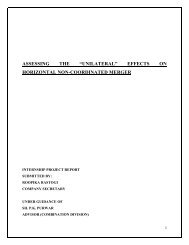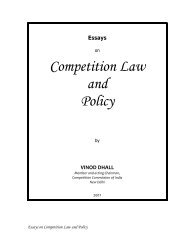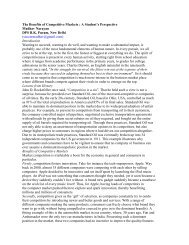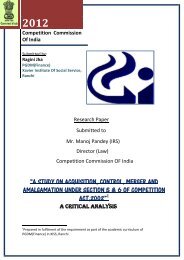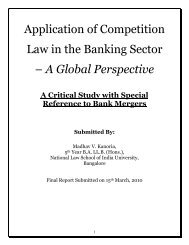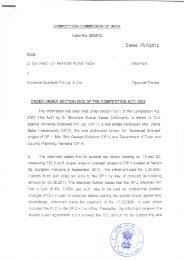applicability of competition law principles on public sector ...
applicability of competition law principles on public sector ...
applicability of competition law principles on public sector ...
Create successful ePaper yourself
Turn your PDF publications into a flip-book with our unique Google optimized e-Paper software.
doctrine immunizes acts <str<strong>on</strong>g>of</str<strong>on</strong>g> the highest levels <str<strong>on</strong>g>of</str<strong>on</strong>g> the state government itself, acting as sovereign;<br />
this includes acti<strong>on</strong>s <str<strong>on</strong>g>of</str<strong>on</strong>g> a state legislature and probably <str<strong>on</strong>g>of</str<strong>on</strong>g> the governor. 29<br />
Thus, it is clear that the noti<strong>on</strong> <str<strong>on</strong>g>of</str<strong>on</strong>g> competitive Neutrality is not prevalent and maintained in the<br />
US.<br />
2.4 Applicability <str<strong>on</strong>g>of</str<strong>on</strong>g> Competitive Neutrality to India<br />
The Government majority held companies are comm<strong>on</strong>ly referred to as Public Sector<br />
Undertakings (PSUs) in India. India adopted a strategy <str<strong>on</strong>g>of</str<strong>on</strong>g> mixed ec<strong>on</strong>omy (<strong>public</strong> and private<br />
enterprises) after Independence since Market failure a major c<strong>on</strong>cern the model <str<strong>on</strong>g>of</str<strong>on</strong>g> ec<strong>on</strong>omy<br />
assigned a major role to PSUs. 30 However, with flux <str<strong>on</strong>g>of</str<strong>on</strong>g> time <strong>on</strong> account <str<strong>on</strong>g>of</str<strong>on</strong>g> lower productivity<br />
and efficiency <str<strong>on</strong>g>of</str<strong>on</strong>g> Public <strong>sector</strong> resulted in ec<strong>on</strong>omic liberalizati<strong>on</strong> policies in 1991 which<br />
shifted the divide between private and <strong>public</strong> in favor <str<strong>on</strong>g>of</str<strong>on</strong>g> a greater role for the private <strong>sector</strong><br />
through removal <str<strong>on</strong>g>of</str<strong>on</strong>g> entry barriers through the mechanism <str<strong>on</strong>g>of</str<strong>on</strong>g> licensing. 31 In India, PSUs still<br />
c<strong>on</strong>stitute an important segment <str<strong>on</strong>g>of</str<strong>on</strong>g> the ec<strong>on</strong>omy, accounting for about 26% <str<strong>on</strong>g>of</str<strong>on</strong>g> the gross domestic<br />
capital formati<strong>on</strong>. 32<br />
Whether the noti<strong>on</strong> <str<strong>on</strong>g>of</str<strong>on</strong>g> competitive Neutrality is enshrined under the Competiti<strong>on</strong> Act, 2002?<br />
The government can enter the <str<strong>on</strong>g>competiti<strong>on</strong></str<strong>on</strong>g> in the market through direct participati<strong>on</strong> i.e. by<br />
engaging in an activity that makes the government department a direct supplier, producer, buyer<br />
through <strong>public</strong> procurement, manufacturer <str<strong>on</strong>g>of</str<strong>on</strong>g> a particular commodity. Government can also enter<br />
through an indirect participati<strong>on</strong> into the market by granting subsides, Tax incentives to certain<br />
industries, enacting policies and regulati<strong>on</strong>s for market regulati<strong>on</strong>. Thus, such interventi<strong>on</strong>s <str<strong>on</strong>g>of</str<strong>on</strong>g><br />
the government can sometimes lead to anticompetitive c<strong>on</strong>sequences in the market. Thus, to deal<br />
with such scenario the Competiti<strong>on</strong> Act includes Government within the definiti<strong>on</strong> <str<strong>on</strong>g>of</str<strong>on</strong>g> enterprise<br />
under secti<strong>on</strong> 2(h).<br />
The Secti<strong>on</strong> 2(h) <str<strong>on</strong>g>of</str<strong>on</strong>g> the Act proved the definiti<strong>on</strong> <str<strong>on</strong>g>of</str<strong>on</strong>g> ‘enterprise’,<br />
“a pers<strong>on</strong> or a department <str<strong>on</strong>g>of</str<strong>on</strong>g> the Government, who or which is, or has been, engaged in any<br />
activity, relating to the producti<strong>on</strong>, storage, supply, distributi<strong>on</strong>, acquisiti<strong>on</strong> or c<strong>on</strong>trol <str<strong>on</strong>g>of</str<strong>on</strong>g><br />
articles or goods, or the provisi<strong>on</strong> <str<strong>on</strong>g>of</str<strong>on</strong>g> services, <str<strong>on</strong>g>of</str<strong>on</strong>g> any kind, or in investment, or in the business <str<strong>on</strong>g>of</str<strong>on</strong>g><br />
29 City <str<strong>on</strong>g>of</str<strong>on</strong>g> Columbia v. Omni Outdoor Adver., 499 U.S. 365, 370 (1991).<br />
30 Ibid.<br />
31 OECD Report 2009, State Owned Enterprises and the Principle <str<strong>on</strong>g>of</str<strong>on</strong>g> Competitive Neutrality, DAF/COMP(2009)37,<br />
available at http://www.oecd.org/newsroom/43125523.pdf<br />
32 Dr. Geeta Gouri, “The Applicati<strong>on</strong> <str<strong>on</strong>g>of</str<strong>on</strong>g> Antitrust Law to State Run Enterprises (SOEs) in India”, available at<br />
http://cci.gov.in/images/media/presentati<strong>on</strong>s/CLandSOE_20100401142732.pdf.<br />
8


